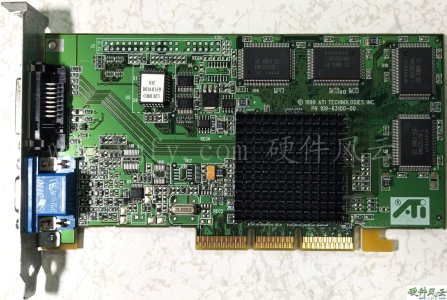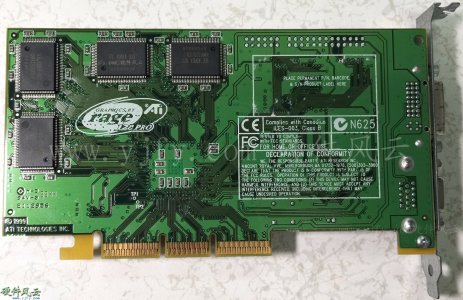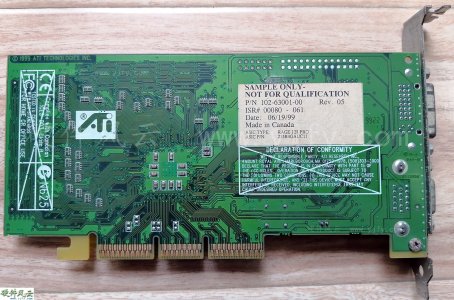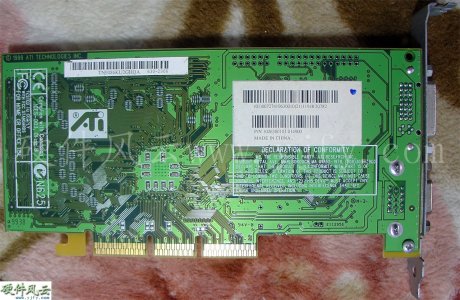History of ATi Graphics cards Vol. 1
yjfy
On August 20, 1985, Lee Ka Lau, P. H. Lau, Kwok Yuen Ho, and Benny Lau from Hong Kong, China founded ATI as Array Technology Inc. in Canada.On December 18, 1985, it was renamed ATI Technologies Inc.
On June 24, 2006, AMD announced the acquisition of ATi for US$5.4 billion and completed the acquisition on October 25, 2006.
In the past 21 years, ATI has dedicated many beautiful graphics cards, even ATI cannot sort out the graphics card information. Many articles related to the history of ATI graphics cards are too superficial, which is not very helpful for computer hardware collectors. As a collector of computer hardware, the author writes a history of ATI graphics cards from the perspective of collection identification, focusing on introducing early ATI graphics cards and engineering sample graphics cards to create a collection guide for ATI graphics cards. In order to fully display the ATi graphics card, this article uses many pictures from collectors and websites. Thank you very much!
1.Graphics Solution series
At the beginning of its establishment, Working primarily in the OEM field, ATI produced integrated graphics cards for PC manufacturers such as IBM and Commodore.
ATI’s early graphics cards have very little information. Fortunately, almost all of them have passed the FCC ID certification, which is an important way to understand ATI graphics card models.
ATI's first product is Color Emulation Card. The card came equipped with a minimum of 16KB of memory. It was used for outputting text to a TTL monitor via a 9-pin DE-9 connector. I have never seen the Color Emulation Card, even the pictures are not left, maybe it is not a standard ISA interface card.
Graphics Solution series graphics cards are the earliest ATI graphics cards and the earliest ATI graphics cards that can be collected. The main chips and components of Ati's early graphics cards were not all developed by itself, but they were keen to put on the logo to declare the brand.
Graphics Solution series graphics cards have four models.
1.1 Graphics Solution
Graphics Solution is based on the UM6845E CRT controller, with the use of Central chip CW16800-A (ATI used ASIC technology to develop the first chip in October 1985), manufactured 8-bit ISA interface graphics card. This card uses the 64KB DRAM,supports Hercules Graphics Card mode and extended 132x25 / 132x44 text-modes on TTL Monochrome monitors,以及All CGA modes on both CGA/EGA and TTL Monochrome monitors。Composite output is available on an internal 3-pin connector (no support for colors, Works only in the 40x25 text-mode or 320x200 graphics modes)
Graphics Solution graphics cards have 3 revisions. Most of the ones that can be seen and collected are the REV 3 version, the REV 2 version is very rare, and the REV 1 or REV 0 version is only seen in the promotional pictures of ATi.
1.1.1 Graphics Solution REV 1

The Graphics Solution graphics card in the picture is from ATI's official announcement picture, which is undoubtedly an engineering sample. It may be REV 1 or even REV 0 . The display chip is Hitachi HD460505SP-1, not UM6845 commonly used by ATI.
yjfy
On August 20, 1985, Lee Ka Lau, P. H. Lau, Kwok Yuen Ho, and Benny Lau from Hong Kong, China founded ATI as Array Technology Inc. in Canada.On December 18, 1985, it was renamed ATI Technologies Inc.
On June 24, 2006, AMD announced the acquisition of ATi for US$5.4 billion and completed the acquisition on October 25, 2006.
In the past 21 years, ATI has dedicated many beautiful graphics cards, even ATI cannot sort out the graphics card information. Many articles related to the history of ATI graphics cards are too superficial, which is not very helpful for computer hardware collectors. As a collector of computer hardware, the author writes a history of ATI graphics cards from the perspective of collection identification, focusing on introducing early ATI graphics cards and engineering sample graphics cards to create a collection guide for ATI graphics cards. In order to fully display the ATi graphics card, this article uses many pictures from collectors and websites. Thank you very much!
1.Graphics Solution series
At the beginning of its establishment, Working primarily in the OEM field, ATI produced integrated graphics cards for PC manufacturers such as IBM and Commodore.
ATI’s early graphics cards have very little information. Fortunately, almost all of them have passed the FCC ID certification, which is an important way to understand ATI graphics card models.
ATI's first product is Color Emulation Card. The card came equipped with a minimum of 16KB of memory. It was used for outputting text to a TTL monitor via a 9-pin DE-9 connector. I have never seen the Color Emulation Card, even the pictures are not left, maybe it is not a standard ISA interface card.
Graphics Solution series graphics cards are the earliest ATI graphics cards and the earliest ATI graphics cards that can be collected. The main chips and components of Ati's early graphics cards were not all developed by itself, but they were keen to put on the logo to declare the brand.
Graphics Solution series graphics cards have four models.
1.1 Graphics Solution
Graphics Solution is based on the UM6845E CRT controller, with the use of Central chip CW16800-A (ATI used ASIC technology to develop the first chip in October 1985), manufactured 8-bit ISA interface graphics card. This card uses the 64KB DRAM,supports Hercules Graphics Card mode and extended 132x25 / 132x44 text-modes on TTL Monochrome monitors,以及All CGA modes on both CGA/EGA and TTL Monochrome monitors。Composite output is available on an internal 3-pin connector (no support for colors, Works only in the 40x25 text-mode or 320x200 graphics modes)
Graphics Solution graphics cards have 3 revisions. Most of the ones that can be seen and collected are the REV 3 version, the REV 2 version is very rare, and the REV 1 or REV 0 version is only seen in the promotional pictures of ATi.
1.1.1 Graphics Solution REV 1

The Graphics Solution graphics card in the picture is from ATI's official announcement picture, which is undoubtedly an engineering sample. It may be REV 1 or even REV 0 . The display chip is Hitachi HD460505SP-1, not UM6845 commonly used by ATI.
































